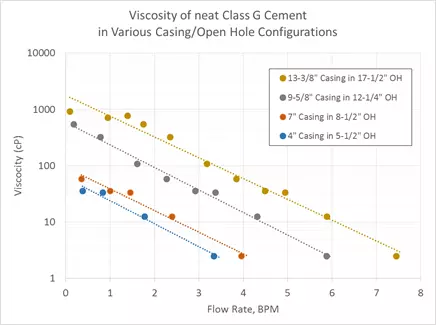Assignment Cement job | Cement Slurry Flow Properties and Mud Displacement
Cement Job Design: Laminar and Turbulent Flow
You are evaluating an intermediate casing string for the Assignment well, and you want to determine the type of flow in the annulus.
The string is 9-5/8″ in a 12-1/4″ Open Hole, and you are using Class G neat cement (density 15.8 ppg).
In this size string, ![]() .
.
Determine whether the flow is laminar, transitional, or turbulent at 1, 2, 3, 4 and 5 BPM.

Solution
![]()
![]()
![]()
![]() taken from the provided graph
taken from the provided graph
So the ![]()
![]()
| Flow Rate (BPM) | Viscocity (cP) | Equation | Re | Flow Regime |
|---|---|---|---|---|
| 1 | 250 | Re= 9356×1 / 250 | 37 | Laminar |
| 2 | 100 | Re= 9356×2 / 100 | 187 | Laminar |
| 3 | 40 | Re= 9356×3 / 40 | 701 | Laminar |
| 4 | 12 | Re= 9356×4 / 12 | 3119 | Transitional |
| 5 | 6 | Re= 9356×5 / 6 | 7797 | Turbulent |
Assessment “Cement job | Cement Slurry Flow Properties and Mud Displacement”
1. What is viscosity?
A .The ratio of pressure to depth
B .The ratio of mass to volume
C .The ratio of stress to strain
D .The ratio of shear stress to shear rate Correct
2. What describes a dilute mix of cement and water pumped ahead of the cement slurry in turbulent flow to help remove gelled mud and filter cake?
A .Cement scavenger slurry Correct
B .Viscosifiers
C .Spacer fluid
3. Which of these hole conditions would be considered favorable for obtaining an optimal cement job? (Select all that apply.)
A .Free of drill cuttings Correct
B .Increasing hole diameter with depth
C .Thick, protective mud cake
D .Consistent hole diameter Correct
E .Free of swelling shales Correct
F .Few doglegs or washouts Correct
4. Identify a characteristic of turbulent flow within the annular space.
A .Fluid moves uniformly as a homogeneous, relatively undisturbed, body.
B .There is no fluid motion transverse to the bulk flow direction.
C .Fluid particles swirl around in all directions. Correct
5. Knowing the ECD when pumping a cement slurry up a casing/wellbore annulus is primarily important to preventing ________.
A .lost circulation due to high wellbore pressure at the casing shoe Correct
B .premature setting up of the cement
C .excessive waiting on cement time
6. Rheological models are used to predict _________.
A .mud displacement Correct
B .compressive strength
C .setting time
D .thickening time
7. Identify examples of non-Newtonian flow models. (Select all that apply.)
A .Power Law Correct
B .Bingham Plastic Correct
C .Equivalent circulating density
D .Herschel-Bulkley Correct
E .Reynolds Law
Recommended for You
Introduction to Well Cementing
 Petro Shine The Place for Oil and Gas Professionals.
Petro Shine The Place for Oil and Gas Professionals.



